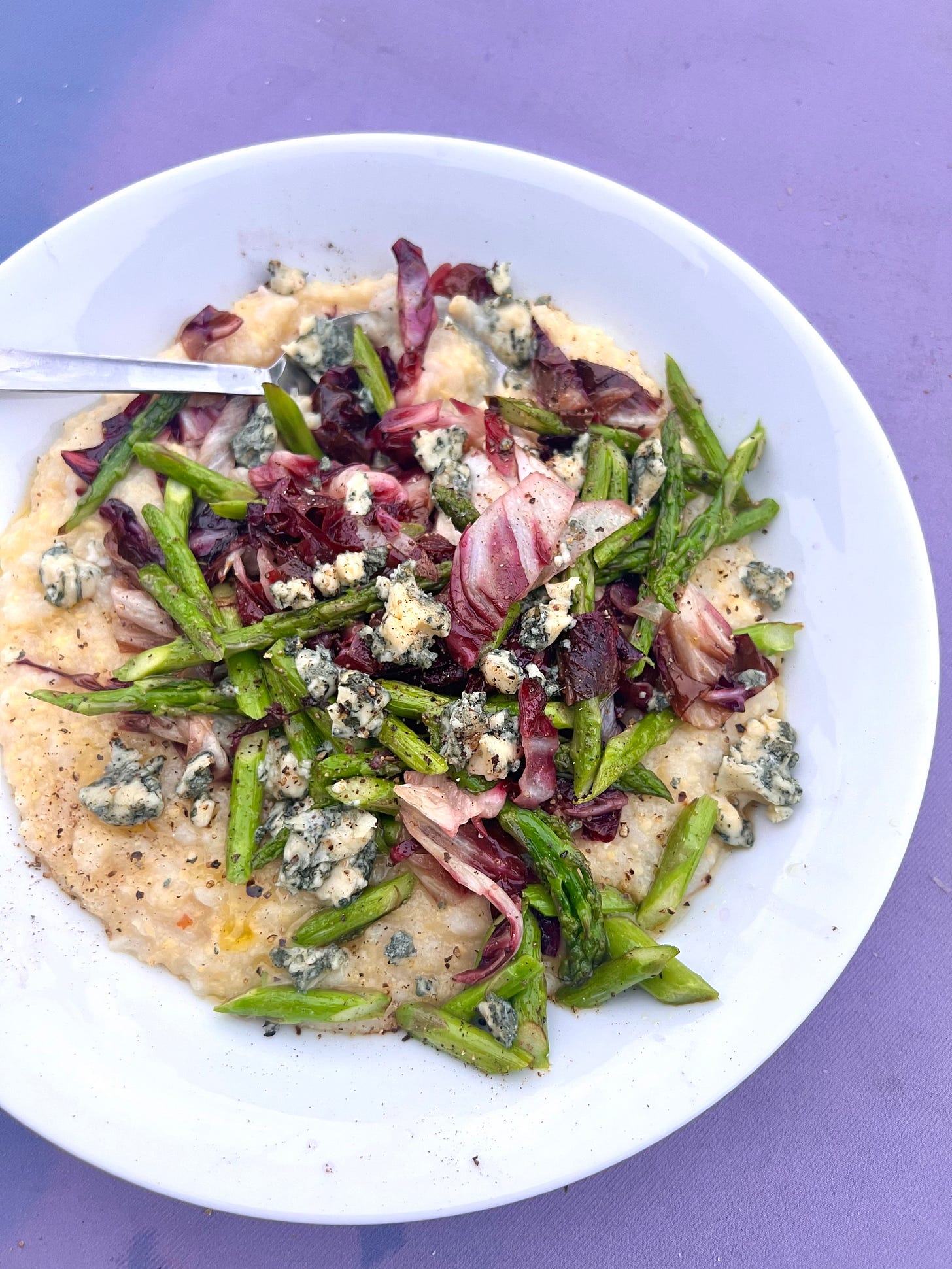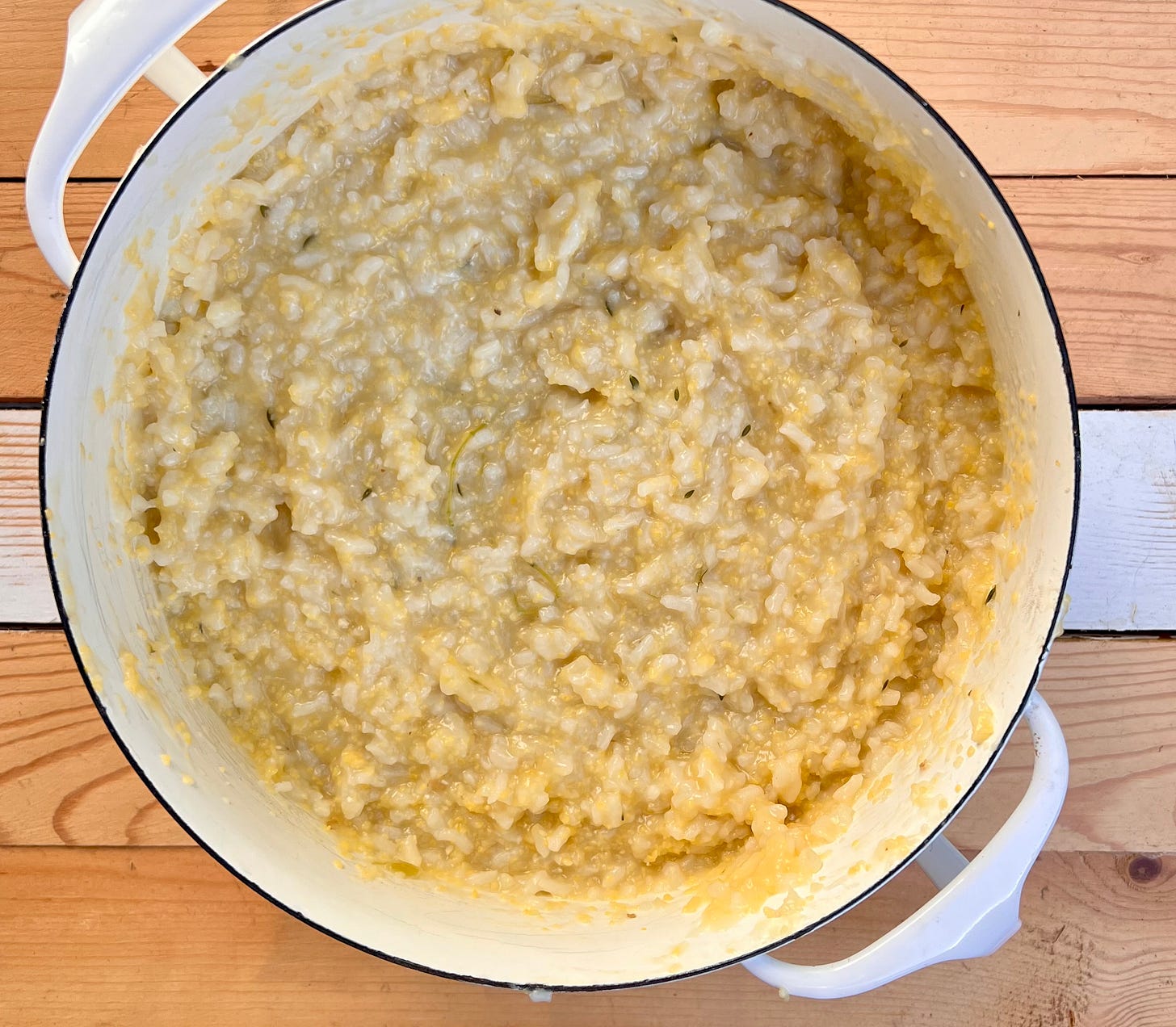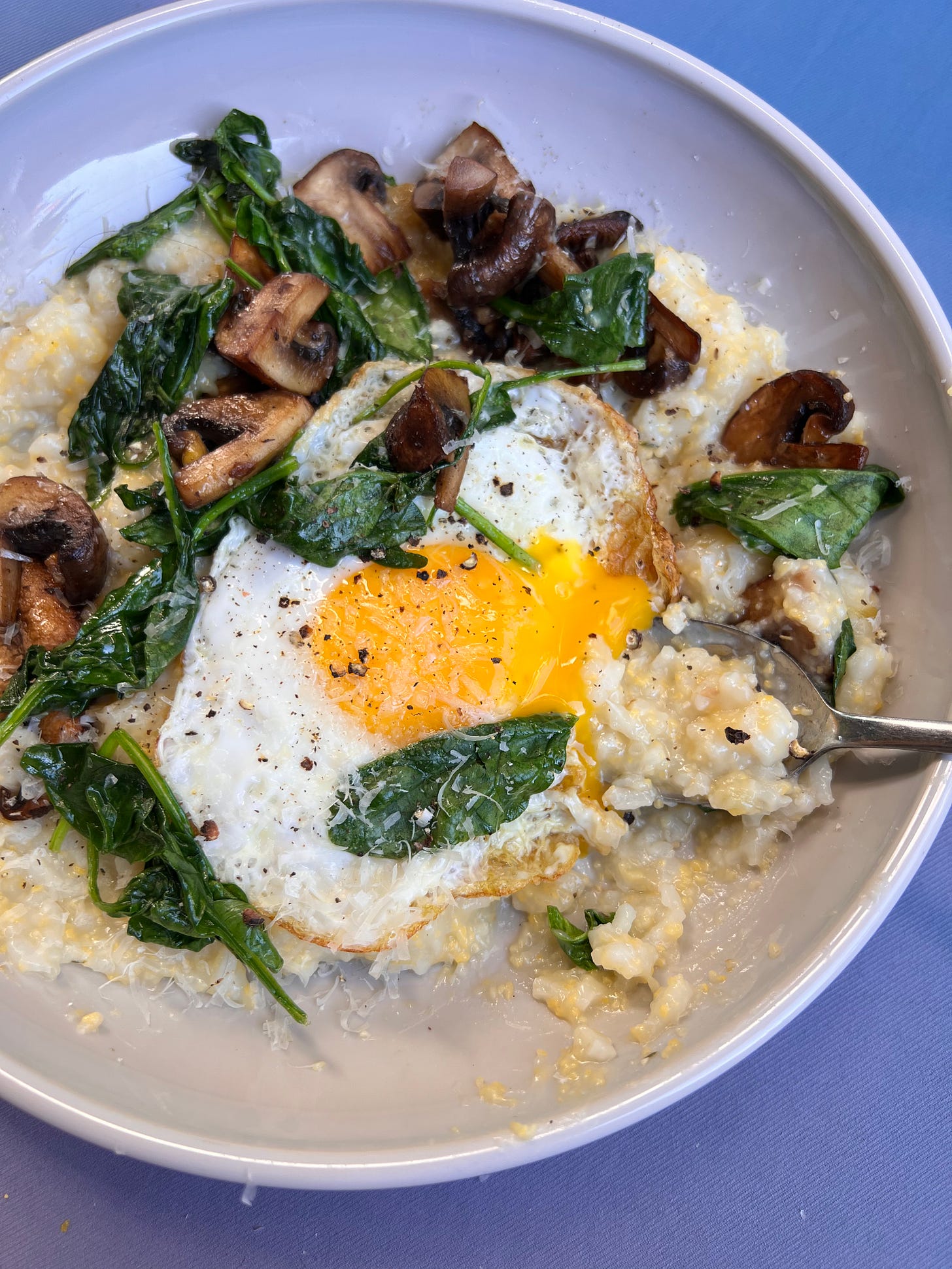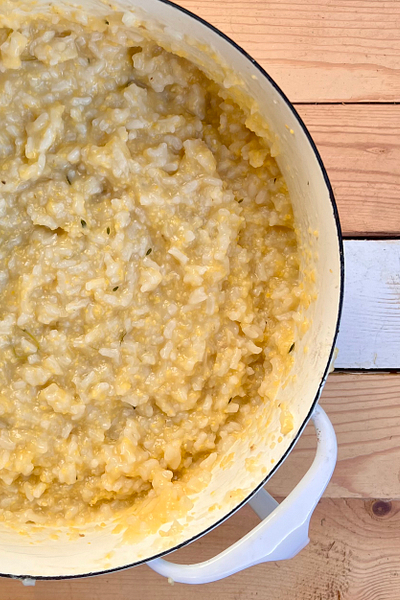Build a Bowl, Not a Bear
Savory Polenta-Rice Porridge: Winter's Coziest Mash-Up
This recipe is a real Goldilocks tale, and not only because it involves porridge.
We’ve all experienced when something’s juuuust right: a mattress, a floater of bourbon poured atop a weak cocktail, an ex (it used to be right).
What about when just right is a bit unexpected, and on a spoon headed towards your face?
Scream it from the rooftops! A new carb is about to replace whatever go-to starchy thing you typically employ for dinner plate duties. Whisk up a batch, serve it ‘round, and prepare to declare, “Voila!” “Eureka!” and “I’m really noodling now!”
I’ve been there: confronting yet another batch of quinoa, farro, chickpeas, rice, pasta, polenta, barley, or couscous, feeling as scintillated by what’s in my bowl as what’s within Topeka’s 1993 Yellow Pages. The other night, bored out of my brain from my pantry’s selection of starch, I thought quite simply, “I love polenta. I love rice. Why have I never cooked them up together?
I added both in equal parts to a flavorful ramen broth, then whisked, stirred, and sighed. WHOA.
WHOA. BUT WHY?
Rice finishes at a faster rate than polenta. And that’s the magic here: When cooked at the same time as polenta (and in the same pot), rice breaks down, lending creaminess while still maintaining the essence of rice through and through. (Which, it turns out, not only stands up to polenta flavor-wise, but also complements it.)
The rice doesn’t turn to mush, though. Nooooo, no. Imagine a bowl of warming, soothing congee encountering a dish of textured, toothsome polenta. The two talk about their similarities, they talk about their differences. They take it a step further and co-mingle, decide they’ve got a good thing going, and realize that they make each other better versions of themselves. They walk off into the sunset together, cozy as hell, fused forever. (It’s unclear who proposed first.)
Leaving their individual identities behind, the power couple emerges as one: Riclenta. (Had a better ring to it than Polentrice.)
BREAKING IT DOWN. AND LEVELING IT UP.
The porridge begins, like so many consumption-worthy dishes do, with aromatics. The idea is to build a quickie, faux-ish broth in which to cook the rice and polenta.
The hack: start with grated aromatics. Yes, grated.
Doing so renders onion, garlic, fennel, and ginger into a nearly pulverized state, thus encouraging faster cooking. When the two grains are eventually added (along with water), the aromatics have already melted into indistinguishable oblivion, obstructing none of the texture of the polenta and rice medley. What lands in your bowl feels like a relationship between two and only two elements. (Did you see a glint of polyamory in the hand-holding love story? Me, neither.)
VEG HEAVY
The versatility of this porridge feels like that of a pair of Levi’s— it goes with just about everything, from roast chicken to comfort-forward, braise-y stews to a pair of heels and a white tee.
But what I feel particularly drawn to is the role it plays as the base for a vegetable-focused main. Name a vegetable. Now roast it, sauté it, or dress it raw, salad-like. Pair it with more of the same. Place spoonfuls atop the porridge, wintery conduit that it is. Drizzle with olive oil, sprinkle with something crunchy, throw some herbs on, grate cheese, and dive into your fridge for condiments and oils and dressings and the like. And just like that, your “voila!” moment: a fridge cleanout, elevated to something worthy of a framed print.
BEARS IN THE WILD. SOME IDEAS:




DIY… THE BEST WAY TO COOK
There’s a customizable element to this porridge: Make it on the thicker side, able to hold its shape and act as a sturdy foundation, like a straight-up bowl of grits or steamed rice, or add more liquid to thin it out to serve more like a loose polenta or congee, able to sop up juices or become one with your components of choice.
You have an option in your ratio of polenta to rice, as well. The recipe as I’ve written it calls for equal amounts of the two. Make this 50/50 version for a real, well, 50/50 experience. For a somewhat creamier, ricier porridge (exact proportion suggestion in the recipe below), increase the rice and decrease the polenta. Some might say that it’s this version that’s juuuust right…
So whatcha think, Goldie? Ready to make a go of it?
SAVORY POLENTA-RICE PORRIDGE
Makes 6 cups; Serves 4
REMEMBER, BEST PRACTICE: READ THE RECIPE ALL THE WAY THROUGH BEFORE YOU START COOKING!
For a slightly creamier porridge, increase rice to 1 cup and decrease polenta to ½ cup. I like using short or medium grain rice for its firmer, pudgey texture, but any rice will work.
As for polenta, go for a coarser grain. And put the instant polenta back on the shelf! A note on whisks: invest in a big, wire whisk. Silicone whisks are unfortunately not your friend in this recipe, or in truth, possibly anywhere.
Serve with: hearty stews, braised meats, roast chicken. Fry an egg on top and add kimchi and cooked greens. Most of all, I love using this base as a conduit for any and all vegetables. Raid the farmers market stands and go wild with roasting and sautéeing. Raw, heartier vegetables (think shaved Brussels sprouts, cabbage, and kale salads) are great sitting atop, becoming slightly softened from the heat of the porridge. Next, condiments: chile crisps, harissa, chutney, crème fraîche, capers, pickles. Herbs, cheeses, nuts, and seeds make great garnishes, too. It’s all about layering textures (and cleaning out your fridge) with a porridge bowl.
Treat this porridge much like you would polenta and rice: finish it with some butter or grated parm. Any leftovers just reconstitute in a pot with a splash of water.
Note: Every polenta and rice variety is different! You may need to add more liquid to thin to desired consistency at the end. If you find that there is too much liquid (but I think this is unlikely), you can just continue boiling until the liquid has cooked off. In this application, these grains are virtually impossible to overcook.
1 small onion (or ½ large), peeled
1 small piece (1-inch) ginger
1 garlic clove, peeled
¼ small fennel bulb (optional)
2 tablespoons unsalted butter
Kosher salt and freshly ground black pepper
6 cups low-sodium chicken stock or water, or a combination of both
¾ cup short or medium-grain rice (I love using sushi or Calrose, but long grain will work, too)
¾ cup medium to coarse polenta (not instant)
3 sprigs thyme
1. Place a box grater directly into a large pot. On the largest holes, grate the onion directly into the pot. Grate enough ginger (no need to peel) to measure ½ teaspoon packed and add to the onion. (The flavor of ginger is meant to be super subtle here, but increase if desired.) Grate the 1 garlic clove and ¼ bulb of fennel (if using) into the pot.
2. Add 2 tablespoons of butter and place over medium heat. Season with salt and pepper and cook, stirring occasionally, until vegetables are tender, about 4-6 minutes. Do not brown.
3. Add 6 cups of chicken stock or water (or a combination) and bring to a boil over high heat. Add ¾ cup rice, ¾ cup polenta, and 2 ¼ teaspoons salt, whisking continuously to incorporate. Add 3 sprigs thyme. Adjust heat to maintain a steady boil and cook, whisking frequently, until the liquid has reduced a bit and the bubbles become bigger on the surface, about 10 minutes. Reduce the heat to low and cover. Continue cooking, whisking vigorously every 5 minutes and being sure to scrape the sides and the bottom of the pot, until the polenta is tender and the rice has broken down and is very soft, about 15-20 minutes more.
4. Adjust consistency to your liking by adding water, ¼ cup at a time, keeping in mind that as it sits, the porridge will get more and more firm. In other words, thin out the porridge a bit more than you might instinctually think to do. Taste. Adjust with salt and pepper and serve.
You can also make in advance and keep covered on the stovetop until ready to serve. You’ll have to add a few splashes of water as you warm and reconstitute.














oh la la - this sounds like the perfect savory breakfast food pour moi
I made it tonight, so delicious:)